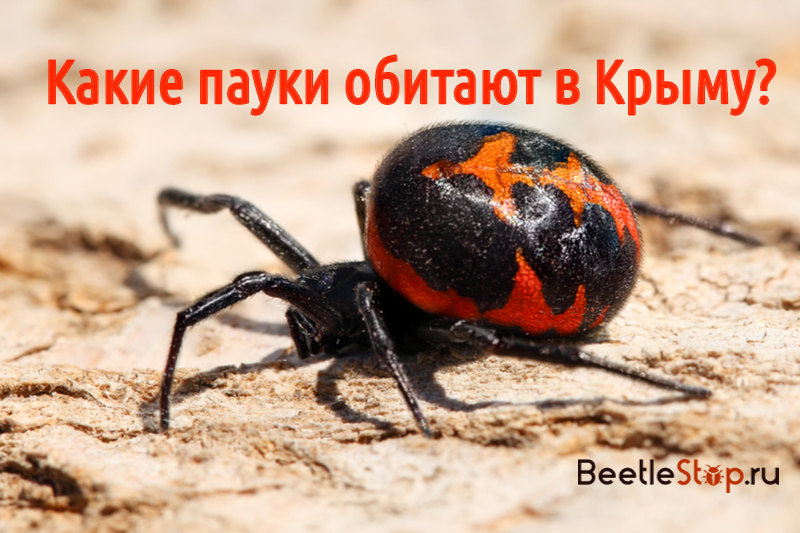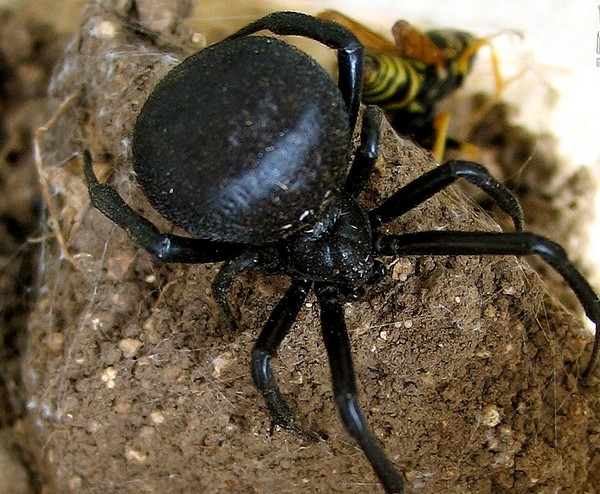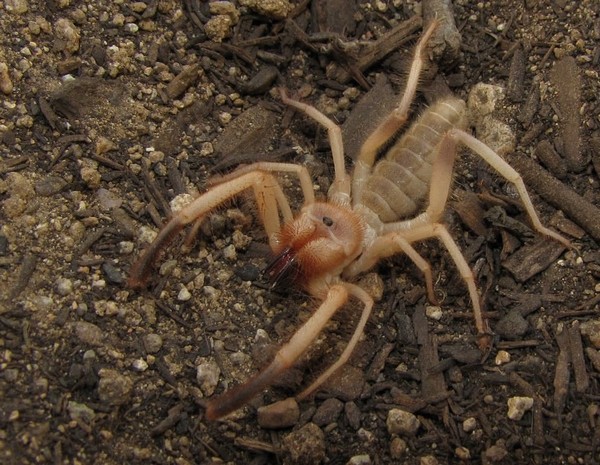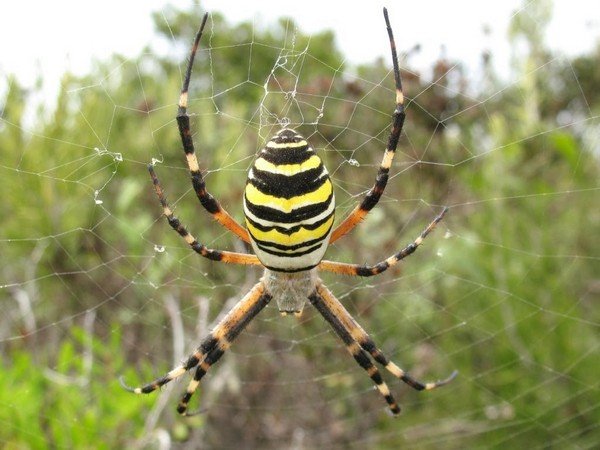Crimea spiders - a selection of photos of the most interesting and dangerous arachnids
Content:

The peculiar climate and landscape of the Crimean peninsula has always attracted tourists. Some prefer to relax in comfortable rooms and only occasionally get out on foot to explore the surroundings. Others, like the heroes of the movie “Three Plus Two,” recklessly climb away from civilization and enjoy sandy beaches, mountain landscapes or steppe open spaces around the clock. However, not everyone knows that Crimean spiders can pose a serious threat to humans and acquaintance with them can end very badly, even to the point of death.
On a note! The subtropical Crimean climate is a favorable environment for the development of poisonous arthropods. With the onset of heat waves, they become more active. Every year, dozens of people bitten by spiders enter the Crimean hospitals.

How many species of spiders live in Crimea
Spiders are one of the most common and numerous orders, both among arachnids and among animals. More than 43,000 varieties are known in the world. In comparison with this figure, the number of species of spiders in the Crimea looks modest - about 500 and about 100 on the Kerch Peninsula. Among them are haymakers, orbiting moths, Eresids, atypuses, and teridiids.
Many of the representatives of arachnids are quite harmless creatures, weave original hunting nets. Often they themselves become victims of a pelopee wasp, which feeds them to its larvae or riders, using spiders as an incubator for breeding.
Dangerous spiders in Crimea there are only 4 species. But a meeting even with one single copy can overshadow the whole rest.
Important! If you notice a crawling spider on clothes or on the body, you need to gently drop it with the click of a finger. In no case do not try to crush it.
Peninsula's most dangerous spiders
Dangerous spiders of Crimea are tarantula, karakurt, salpuga and argiope. Mostly they live in a wild, natural environment. It is extremely rare to visit a person’s housing, but still such cases are not excluded.
Karakurt - a poisonous inhabitant of the Crimea
The most dangerous representative of spiders recognized karakurt. He eats insects. Favorite habitats are rodent burrows, from which the spider easily expels the inhabitants. Even if the mouse decides to confront the karakurt, it instantly dies from its bite. Also settles between the stones, in the cracks of the rocks. He sets his hunting nets in the grass, in the steppes and even in suburban areas. From the Turkic name “karakurt” literally translates as “black worm”, a photo of the dangerous spider of Crimea is presented above.
What does the most dangerous spider of Crimea look like:
- Mature females of saturated black color with a glossy tint, up to 2 cm long.
- The length of the males does not exceed 7-8 mm.
- Young and male individuals have 13 red spots on their abdomen. Sometimes they are framed by a white border.
- Two pairs of eyes help you navigate well during the day and night.
- Messy networks are located primarily on the ground itself.
Karakurt are very prolific. Periodically with an interval of 10-12 or 25 years, a massive outbreak of population growth is noted. Winter time is spent in cocoons, which are several pieces suspended in nests. In the middle of spring, a young generation appears and is carried on the web by the wind. At the end of June, becoming sexually mature, females and males look for shaded places and weave nets for mating.
Interesting! Due to the bloodthirstiness of the female during mating, karakurt is also called black widow. The mating games of the female are very peculiar - at the end of the process, she eats the male. The female’s appetite is excellent: up to 5 candidates can simultaneously be in her network for mating.
The life cycle of males ends in mid-July. Females, after mating, look for new places, weave a net and lay offspring. After the last laying, the eggs die.
How to bite karakurt
Representatives of the genus of black widows are not characterized by aggressiveness towards humans. Only if they feel danger, defend their lair — are they able to attack people in emergency cases. Most often, this type of spider in the Crimea bites by accident. This is due to the peculiarity of their reflexes. When pressed on the abdomen, they release poison, for this reason the crawling spider in the body should not be slammed, but carefully discarded.

On a note! After picnics, going outdoors, it is recommended to inspect things, as spiders can easily climb into them. It is best to walk in thickets of grass in closed high shoes, and work in gloves at summer cottages and fields.
The concentration of toxic components in karakurt is 15 times higher than that of a rattlesnake. This feature is due to the fact that spiders are constantly fighting rodents and other small mammals, and to neutralize them you need strong poison. In humans, the probability of death after a bite is 2-4%. The poison has a neuroparalytic effect.
Symptoms of a bite of a karakurt:
- the appearance of severe burning pain, which intensifies and spreads throughout the body within 15 minutes;
- difficulty breathing
- dizziness, possibly blue skin on the face;
- disturbances in heart rhythm and kidney function;
- cramps, muscle cramps in the abdomen;
- depressed state, the emergence of a feeling of irresistible longing and fear of death.
On a note! Sensations of the bite field depend on the pain threshold of a person. There are cases when people in a dream did not notice that their bit spider.
What to do if bitten karakurt:
- The most effective way to eliminate the consequences of a bite of the most dangerous spider in Crimea is the introduction of serum. However, it is not always available at medical points. In its absence, an intravenous injection of potassium manganese or calcium gluconate is administered. The need for re-injection is determined by the condition of the victim.
- In the field, the cauterization method, which was developed by Marikovsky, is used. Immediately after the bite, in order to neutralize the effect of the poison, 3 matches are applied to the wound (heads to the wound), and the fourth is set on fire. High temperature destroys the protein structure of the poison and thereby avoids poisoning the body.
Tarantula - the largest spider in Crimea
The very name of a large spider in Crimea instills fear, and the photo is completely capable of provoking arachnophobia. Tarantulas belong to a large family wolf spiders. The size of an adult reaches 3.5 cm. A gray shaggy body and the same shaggy legs are the “visiting card” of a spider.
On the Crimean peninsula, you can meet tarantulas in arid regions and steppes. In the daytime, they take refuge in underground vertical burrows, the depth of which can reach 60 cm, waiting for the heat. Go hunting at night. Caterpillars, grasshoppers, flies, moths, bears and other small insects become victims of spiders. Unlike most arachnids, the tarantula does not weave hunting nets.Seeing the victim, he quickly catches up with his long, furry paws and injects his poison into it.
Interesting! Females show amazing care for offspring. After mating at the end of summer, the female is removed to the mink, lays eggs and scrupulously braids them with cobwebs. The formed cocoon before the appearance of young animals, she carries with her everywhere. Emerging newborn individuals are still on the abdomen of the female for some time.

Man is not of interest to the giant spiders of Crimea. On the contrary, having heard the vibration from human steps, he tries to hide away. Can bite only in case of self-defense. Feeling after a bite is comparable to a bite of 2 bees or one hornet. The appearance of allergic reactions to tarantula venom, which are manifested by a febrile state, nausea, pain in the muscles, is possible.
Previously, in Italy, Spain, in order to neutralize the spider venom, they went into a frantic dance. Now it’s enough to treat the wound with brilliant green or alcohol solution, apply a cold compress and provide peace to the victim.
Solpuga - an inhabitant of the southern coast
Solpugs, they are also phalanges, another interesting species of spiders in Crimea, listed in the Red Book. They live in arid areas, mainly in the foothills of the southern part of the peninsula. Activity is shown at night. The body length can reach 5-7 cm. The whole body and legs are covered with hairs. The forelimbs resemble tentacles. They feed on insects, small lizards, scorpions. The device of complex eyes, which provide an instant reaction, visibility in the dark, make excellent hunters out of a salpug.

In South Africa, such arachnids are called hairdressers. This name has taken root because of the developed strong front tentacles, through which they are able to deprive a person of hair on his head, as well as animal hair. With “trimmed” hair, spiders line the bottom of their nests.
Small individuals can not cause harm to humans, since not yet fully formed chelicera are able to bite through the skin. But a meeting with an adult spider does not bode well. Their chelicera are equipped with teeth and the bites are very painful. And although the spider does not inject poison with a bite, the remains of previous victims are preserved on its jaws, which can penetrate the wound and provoke rot. It is noteworthy that the salpugs are not afraid of people and can easily join gatherings near the fire.
Argiope - the most original spider in Crimea
The color of the abdomen of a spider is very similar to the aspen color. Alternating yellow and white stripes give the arachnid an unforgettable look. This representative is by no means uncommon in the Crimea and you can meet him in the steppe, forest zone.

Because of the striped color, many more names appeared: zebra, spider-wasp. Body dimensions do not exceed 1.5 cm. The peak of activity occurs in the evening and night. Spiders weave a web of complex design. At the same time, it takes no more than an hour to create a hunting network. The individual itself is located in the center of the structure and hangs head down. Grasshoppers, locusts, filly are favorite spider treats.
The bite of an argiope does not represent a mortal danger to humans. In the affected area, suppuration, abscesses may appear, in the worst case, the development of tissue necrosis. In people prone to allergies, allergic reactions to spider poison are possible.
Important! Whatever spider bites you, in no case can you put a tourniquet. Circulatory disorders can lead to necrosis of the limb. It is also forbidden to cut wounds and incisions near them.


 (votes: 36, average rating: 4,81 out of 5)
(votes: 36, average rating: 4,81 out of 5)
Spiders are cute ... I love spiders.Do you have a few spiders at home, but as pets?
And I'm terribly afraid of them ...
Tonight I met a salpuga while fishing ...
A little heart attack did not happen))
Creatures are cute, but do not inspire confidence)